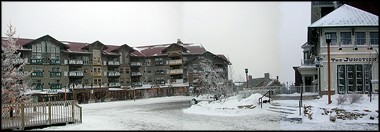
|
|
|
When Mother Nature isn’t cooperating, some ski resorts opt to stretch the truth a little in their condition reports.
West Virginia’s Snowshoe Mountain Resort tends to tell it like it is, good or bad. But with a high elevation (just under 5,000 feet) and an average annual snowfall of 180 inches each winter, Snowshoe doesn’t have much need to get creative with condition reports.
And, sometimes, as I discovered Saturday, Snowshoe is downright modest in its reports. Saturday’s condition report called for 4 inches of new snow (the real kind), but by the time the lifts started running, the snow was still falling fast and furiously, adding inch by inch throughout the day. Definitely a lot more than 4 inches by the time the storm blew out Saturday evening.
When I headed to Snowshoe this past weekend with Matt, an old college buddy, I expected to find good conditions but didn’t plan on having a powder day Saturday.
If I sound like I might be complaining, I’m not.
Some light snow began falling Friday night as we arrived at the resort. After checking into our condo, we headed to the Silver Creek area, which is open for night skiing until 10 p.m. As usual, there were no crowds at Silver Creek, and the conditions were plenty good.
Most of the slopes at Silver Creek are lit for night skiing, including the Mountaineer Terrain Park, which is open to adventurous boarders and skiers alike. The Ruckus Ridge Tubing Hill is also open for some sledding fun. The lighting at Silver Creek is exceptional; the slopes are bathed in bright light with no dark areas.
This year, Snowshoe is offering a unique nighttime program at Silver Creek: the Night Movers Snowboard Clinic. This $30 evening program is designed to allow skiers to try out snowboarding, without cutting into precious ski time during the day. Snowboard rental and lesson are included. The program is offered Tuesdays, Thursdays, and Saturdays.
I stuck to skiing on Friday night, adjusting to a new pair of Salomon X-Wave 10 boots. The light snow made conditions perfect, and also made the skiing surreal, with flakes of snow reflecting in the lights. The entire sky glowed white, and with a light wind, the snowflakes seemed to hang and dance in the air, in no hurry to reach ground.
After a couple hours of skiing and a quick bite to eat at the Bear’s Den, an eatery at Silver Creek, it was time for bed. (My dinner: a Philly Cheesesteak. Not quite as good as the real thing, which I got used to while going to college in Philadelphia, but not too shabby.) By now the snowfall was letting up.
Normally, I would have been up early Saturday morning to tackle the slopes as soon as the ropes dropped.
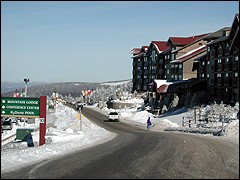
|
|
Day after the storm. Plenty of sunshine smiled on skiers and boarders Sunday. Photo by M. Scott Smith.
|
When I finally rolled out of bed shortly after 9 a.m., I peered out the window and saw fresh snow everywhere - with plenty still coming down. The slopes beckoned, and I heeded their call.
We drove down the road and parked near Top of the World, donning our skis and heading down Upper and Mid Flume to the base of the Ball Hooter high-speed quad. With the fresh snow, the slopes were in perfect shape.
Saturday can be the busiest day at Snowshoe, we discovered, as a long line greeted us at Ball Hooter. Although the line was long, several lift attendants did a fine job directing traffic and ensuring each chair was full. One cheerful attendant handed out Fire Ball candies to anyone willing to let out a “hoot.” He wasn’t looking for yelps or yahoos or yeehas, he explained, just a West Virginia hoot. This provided much entertainment and made the line seem to go faster.
After a couple more runs in the main Snowshoe area (now called the Northern Tract), we decided to cross the road to the Western Territory. (This seems like a ripe area for a “why did the chicken cross the road” joke, so feel free to add any in the Reader Comments section below.)
From past experience, I expected there to be few crowds in the Western Territory, and this was the case Saturday. The Western Territory is home to Cupp Run and Shay’s Revenge, two advanced trails that drop 1,500 feet in 1.5 miles. They end up at the base of the Western Express high-speed quad, which whisks skiers and boarders back up to the top in about 6-7 minutes.
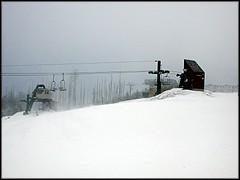
|
|
Top of the slopes, just after the lifts shut down. Photo by M. Scott Smith.
|
However, after making a few turns, the rest of Cupp and Shay’s had perfect, powdery conditions and were sheltered from the fierce wind.
We spent most of the day in the Western Territory, having a great time alternating between Cupp Run and Shay’s Revenge.
We also made several runs down Lower Shay’s Revenge, the only trail at Snowshoe rated as a double-black diamond. Lower Shay’s has an extremely steep pitch and is usually left ungroomed to bump out. On Saturday, big powdery moguls dotted Lower Shay’s, with hardpack in between the moguls. The powder made Lower Shay’s a little easier, keeping speeds down.
When I ski challenging terrain, grace is usually the first thing to go, and I can’t say that I skied Lower Shay’s with grace. However, I did make it down multiple times with my self esteem intact, which is more than I can say for many of the skiers attempting to make their way down.
Unfortunately, Lower Shay’s was littered with a number of skiers who clearly had overestimated their ability. At any given time, a few skiers stood (or sat) motionless throughout Lower Shay’s, evidently wondering what they had gotten themselves into. I saw several trying to slide down slowly on their rear; another less fortunate individual made his trip down in a Ski Patrol sled.
With so many human obstacles, it became difficult to choose a path down, and this led to more people standing and waiting. The powdery conditions made Lower Shay’s as easy as it can get, so I think a lot of people just wanted to be able to say that they had tried it.
After our legs began to wear out in the afternoon, we headed to the Northern Tract and made our way towards the Widowmaker lift. By now, Ball Hooter had no lift line. People had spread out, or possibly called it a day. With the wind still blowing, the last leg of the lift ride on Ball Hooter was a chilly one, as the lift crested the mountain peak.
Back in the condo, we set our minds to our next task: picking a place to eat.
Have you been to Snowshoe lately?
If you haven’t been there in the past few months, you haven’t seen the “new” Snowshoe. Plump with cash from parent Intrawest ($82 million in the past four years), Snowshoe has undergone a remarkable renaissance. In addition to new trails, lifts, and programs, Snowshoe has been busy building the new mountaintop Village at Snowshoe, which offers slopeside lodging, shops, and restaurants.
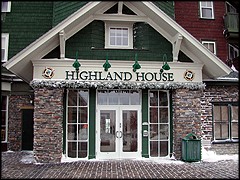
|
|
Highland House. Highland House is Snowshoe’s newest development, including restaurants and lodging. Photo by M. Scott Smith.
|
Located in between the Shavers Centre and the Mountain Lodge, the Village at Snowshoe has a very western ski town feel to it, with incredible mountaintop views.
Pedestrians can wander along brick-lined paths, peering into the windows of restaurants such as The Junction, Cheat Mountain Pizza, or Foxfire Grill, or ducking into Stellar Coffee for some hot cocoa after a long day of skiing. Shops include the Whistler Candle Company, with “fresh baked candles,” and Rocky Mountain Chocolates, with all kinds of tempting treats including a wide variety of candy-coated apples. If you’re looking for t-shirts, you will of course find a selection of shops to please.
We decided to grab dinner at The Junction, a new restaurant with an authentic locomotive ambience and decor. The restaurant calls back to the old logging days of West Virginia. Indeed, the nearby Cass Scenic Railroad State Park (20-30 minutes from Snowshoe) allows visitors to travel to the 4,860 foot summit of Bald Knob on authentic Shay steam locomotives.
In addition to its unique decor, The Junction features an open kitchen, so you can watch all the cooking action. There was also live music. Dinner specialties include fresh trout and rotisserie chicken. For dessert, try out the cobbler.
After dinner, we decided to head back to the slopes, but not for skiing.
The Snowshoe Outdoor Adventure Center believes that snow is good for a lot more things than just downhill skiing. To that end, the Center offers snowshoeing, nordic skiing, guided snowmobile tours, dog sledding, and horse drawn sleigh rides.
For a real adventure, we signed up for a nighttime snowmobile tour. The one-hour tour ($50 per person, $15 for second person on same snowmobile) starts with a brief video, instruction, and helmet fitting. Then it’s off to the waiting snowmobiles, which are gased up and ready to go.
Our tour left at 8 p.m. Two guides accompanied about a dozen snowmobilers, with one guide leading and the other following in the rear. Following in a line, we were off - climbing up and down green and blue trails throughout the main Snowshoe area at speeds up to 25-30 miles per hour.
I first tried snowmobiling last January at Winter Park, Colorado, and was immediately addicted. Snowmobiling at night adds another unique dimension, with the slopes lit only by the headlights on our snowmobiles.
I had a blast snowmobiling at Snowshoe, and will definitely make it a standard part of future trips.
Once the tour was over, we stopped by Stellar Coffee for some drinks and chocolate croissants. A musician there sang and played a variety of instruments.
Sunday morning, it was time for the long drive home. By now the storm and winds were gone, leaving behind sunny skies, great conditions, and plenty of smiling skiers and boarders.
Snowshoe Mountain Resort continues to evolve, offering a selection of terrain, year-round activities, restaurants, and lodging options unparalleled in this region. And, as we discovered Saturday, Snowshoe has a climate all to its own, bringing plenty of fresh powder each winter. Snowshoe offers a slice of western skiing without losing its unique West Virginia Appalachian feel - each trip offers something new to discover.
M. Scott Smith is the founder and Editor of DCSki. Scott loves outdoor activities such as camping, hiking, kayaking, skiing, and mountain biking. He is an avid photographer and writer.
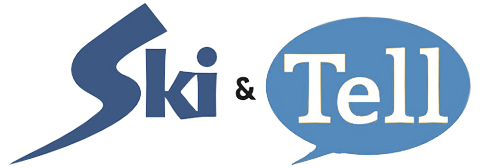
Join the conversation by logging in.
Don't have an account? Create one here.